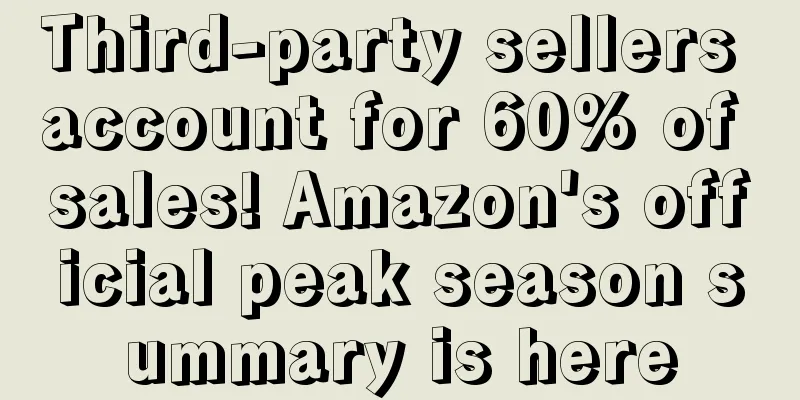Third-party sellers account for 60% of sales! Amazon's official peak season summary is here

|
Last weekend, Amazon released an overall summary report for this year's peak season, stating that this year was Amazon's best peak season in 20 years. Amazon officials said that during this year's peak season, more than 60% of sales came from third-party sellers on the platform, a higher proportion than last year's 50%. Most of them came from small and medium-sized sellers. In categories including home, beauty, kitchen, toys and clothing, consumers prefer to choose new brands and new products with more competitive prices. In some officially announced new brand sales cases, 3P sellers' sales during the peak season in the fourth quarter increased by about two to four times, with the highest growth rate for a board game seller even exceeding 800%. The official will certainly pick out the good things in the report, so let's analyze it from some points other than the content of the report. First of all, the release time of Amazon's report is quite intriguing. Generally speaking, Amazon releases the peak season overview report about a week after the end of Cyber Monday, but this year it took nearly a month to come up with a report without any specific data. You should know that the peak season overview reports of last year and the year before last both had specific category performance and partial data. The 2020 report even wrote about the specific sales of third-party sellers during Black Friday Cyber Monday. In contrast, this year's report only has one overall data: "third-party sellers account for more than 60% of sales", and then only some seller cases, and other overall data are kept silent. Only when Amazon's Q4 financial report comes out can we get a glimpse of how Amazon really performed during this peak season. Of course, this report is not meaningless. At least we know one thing: Amazon's self-operated business is indeed giving up its market share step by step. On the one hand, it has an anti-monopoly effect, and on the other hand, there are too many sellers for the official self-operated business to handle. However, the concession of self-operation will definitely lead to Amazon increasing its efforts to cut leeks in other aspects. It is foreseeable that the price of Amazon's third-party seller services will inevitably rise. During the peak season last year, some media reported that Amazon received at least $121 billion in monthly revenue from third-party sellers in a year through various forms of fees such as platform monthly rent, commissions, FBA fees and advertising fees. This figure accounts for about 34% of the sellers' total sales! This is equivalent to paying Amazon $34 for every $100 product sold by the seller. This year, Amazon has charged in various ways under various pretexts, such as fuel and inflation surcharges in the middle of the year, and peak season delivery surcharges at the end of the year. So this year, the proportion will only be higher. Amazon is gradually changing from self-operation to a pure platform to earn commissions. Presumably this is also one of the official means to avoid the future split of the business. |
<<: The real trump card: the supply chain advantage brought by China's industrial clusters
>>: Amazon's biggest layoffs in history! Why did its stock price rise instead of falling?
Recommend
Costco enters the fast fashion industry with TikTok's popularity exceeding 1.8 billion!
It is learned that users on TikTok and other socia...
What is AdPlexity? AdPlexity Review
Adplexity is a competitive intelligence tool that ...
How to choose the e-commerce platform with the highest advertising ROI? These data are worth knowing
It is learned that eMarket recently released its l...
Increase GMV and improve purchase rate! Shopify launches new localization tools!
<span data-docs-delta="[[20,"增加GMV提高购买率!Sh...
What is Customer.io? Customer.io Review
Customer.io is a tool that helps you create ideal ...
What is a Pangolin? Pangolin Review
Pangolin is a global developer growth platform tha...
The United States extends tariff exemptions for some Chinese products! These categories will benefit
It is learned that on May 27, the Office of the Un...
What is Hub by Amazon? Hub by Amazon Review
Hub by Amazon is similar to the domestic Fengchao ...
The Middle East "Taobao" collapsed and became inaccessible, suspected to be closed!
So surprised! JollyChic, known as the Taobao of th...
Ranked as the No. 1 port in the United States for 22 consecutive years! The container handling volume of the Port of Los Angeles set a record in March!
<span data-shimo-docs="[[20,"连续22年稳居美国第一港!...
Temu front-end prices skyrocketed overnight! Fully managed sellers' sales plummeted?
At the beginning of 2025, the repeated changes in ...
With a monthly salary of over 30,000, another cross-border job is in high demand!
Under the AI revolution led by ChatGPT, AI-relat...
What is Rongsheng Overseas Warehouse? Rongsheng Overseas Warehouse Review
Shenzhen Wingsing Supply Chain Co., Ltd. is a one-...
The most complete process of WOOT flash sales + tutorial on clearing goods and transferring inventory
This issue's useful information 1. The most co...
What is Dash Button? Dash Button Review
Amazon Dash is a plastic button that can be hung o...









